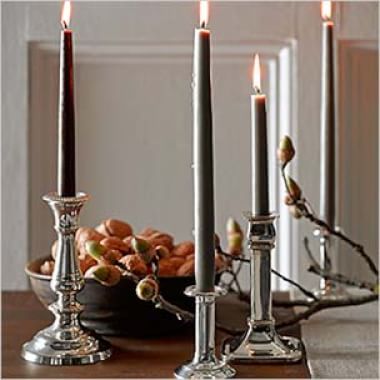
Setting the Scene
Whether your celebration will be formal or casual, you need to plan in advance how to set up and decorate your space. Begin by choosing a color palette that looks good with your tableware and the room. This palette will help you create a centerpiece, place settings and room decorations that will work together to set a festive mood. Stick with two or three colors and a few complementary textures, such as wood, pewter and foliage. The keys are restraint and simplicity.
Serving Styles
Assess your menu, guest list and level of formality to determine whether to serve the meal buffet, family or restaurant style. Whichever you choose, offering drinks and appetizers before the meal is a warm, welcoming way to start the Thanksgiving meal.
Buffet service is the tried-and-true approach for Thanksgiving because it works equally well for formal and casual entertaining, and makes it easy to organize and serve large quantities of food. Guests make their way through the buffet line, helping themselves to as much of each dish as they want. Once you set out the food, all you have to do is replenish the platters as needed. For large groups, set up a separate buffet station for self-serve beverages, like wine and sparkling water.
Family-style service is well suited to less formal Thanksgiving meals and smaller groups. Choose platters that are small enough to be passed comfortably. Consider serving the turkey on two platters, with light and dark meat on each, instead of on a single large platter, which can be cumbersome. It is helpful to have a sideboard or extra serving table for setting the platters when they are not being passed; this also makes it easier for you to refill platters and bowls. Put bottles of wine and water directly on the table.
Restaurant-style service, in which dishes are individually plated in the kitchen or served by the host from the head of the table, is elegant but involves last-minute work. It is a good option for intimate groups, for simpler meals such as Thanksgiving weekend breakfasts, and for more refined sit-down celebrations.
Decorative Elements
Here is a basic rule for decorating the Thanksgiving table: Repeating patterns create a pleasing effect. This can be achieved by limiting decorations to a few beautiful elements in a few colors. They can be elegant, earthy, antique, modern, refined or whimsical. You can use virtually anything, from a splendid crystal bowl to a humble terra-cotta flowerpot, as long as the total look remains focused and harmonious.
Choose articles that have a special significance for you and your family, such as an heirloom candelabra or platter. Or, select items that fit the mood of the season, such as fresh or dried flowers, pomegranates, apples, pumpkins and squashes, nuts, autumn leaves and branches, and sheaves of wheat. Use a few of these to create a centerpiece, to adorn a central table runner, to add an accent to each place setting, and, if you wish, to decorate the buffet, entryway and mantel.
Select candles that complement these elements. They should be either short, such as votives or pillars, or tall enough so that the flame remains above eye level when guests are seated at the table.
Lighting
Dimming overhead lights and using candles or table lamps for illumination is an easy way to bring focus and sparkle to the table, even in the afternoon light. For an elegant setting, use tall tapers (dripless and scent free) set in candlesticks or candelabras. Silver, pewter or crystal candleholders add a formal touch to the setting. Classic ivory-colored candles go with virtually any setting and color palette. For a more casual gathering, line up votives in pretty glass containers or squat pillar candles along the center of the table or around the centerpiece for a glowing effect. Whatever kind of candles you choose for the table, add matching ones to the buffet to help tie the room together.
Seating
Do not worry if your chairs are mismatched. Thanksgiving is a perfect time to be creative with seating, and an eclectic assortment of chairs or even a rustic wooden bench lined with cushions can be inviting and attractive. To create a unified look, use colored ribbon to tie a sprig of leaves or berries to the back of each chair, or use single-color accent chair cushions.
When making your seating plan, consider whether each guest will be comfortable in the chair he or she has been assigned, and seat gregarious guests next to those who are more quiet to keep the conversation balanced. Seat children between adults or set a separate table for the younger guests.
Adapted from Williams-Sonoma, Thanksgiving Entertaining, by Lou Seibert Pappas (Simon & Schuster, 2005)








